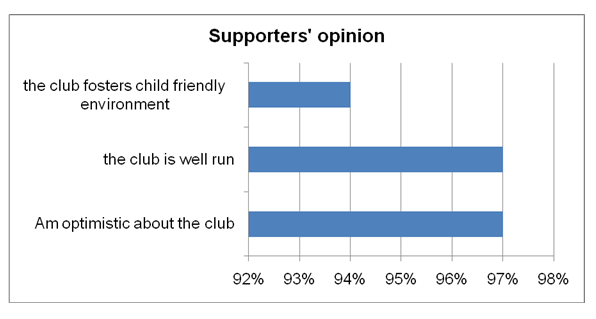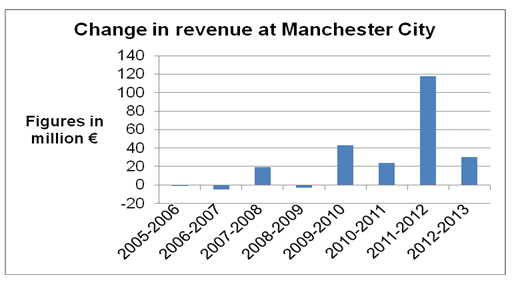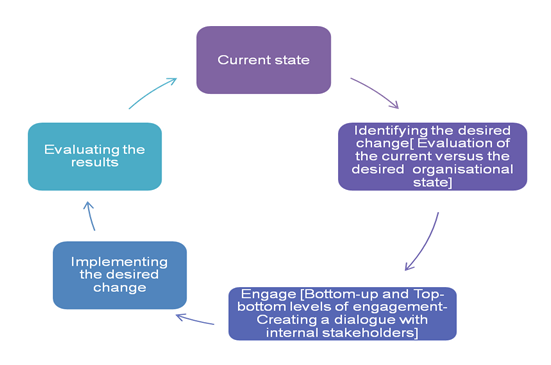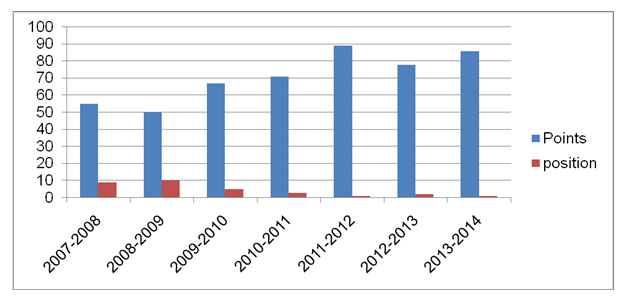Abstract
This report entails an analysis of leadership and change in Manchester City Football Club. The report assesses the transformation that the football club has undergone since its inception in the 1800s to its current position. The report is organised into a number of sections. The first section entails a brief introduction, which provides an analysis on the high rate of commercialisation in the football industry.
The organisational changes that have been implemented such as change in club ownership are highlighted. The second section entails a literature review on leadership and organisational change. This section also evaluates the change management cycle that organisational leaders should take into account in the process of implementing change.
The third section entails an analysis of Manchester City Football Club and the transformations that have occurred since its takeover in 2008. The most applicable leadership theory to the case is also identified and explained. Finally, a conclusion and a number of recommendations on what the club’s management team should do in order to improve the club’s long-term survival and sustainability are highlighted.
Introduction
Most people perceive sports as a way of spending their leisure time, while others consider it as a business. Football ranks amongst the highly commercialised sports in the world. Different football clubs have been established in the European region since the 1850s. The transformation into business can be traced back into the 1850s when football clubs started to compensate their players financially.
Subsequently, football clubs moved from being mere sporting associations into businesses. Nash (2000, p.465) holds that the ‘rate of commercialisation increased during the 1980s, as evidenced by the high rate of involvement by business institutions and corporations into the industry’.
Currently, football is considered as an international business. Subsequently, the industry is experiencing huge investments. In 2003, Roman Abramovich, a Russian billionaire, bought Chelsea Football Club for US $233 million while a Qatari billionaire bought Paris Saint German. Similarly, Mansour Bin Zayed Al Nahyan bought Manchester City Football Club.
The commercialisation of most professional football clubs has led to an increment in the clubs’ revenue. Some football clubs have lost their organisational culture due to commercialisation. Some football club supporters are not pleased with the high rate of commercialisation in the football industry.
Nash (2000, p.469) asserts, ‘some supporters have shown their discontent and have contested the fast changing state of modern football’. This report evaluates the changes that have occurred in Manchester City Football Club since its takeover by Sheikh Mansour bin Zayed Al Nahyan. Some of the issues that will be evaluated relate to the management team, player acquisition approach, and the high payments.
Leadership and organisational change
Siraj-Blatchford and Manni (2007) posit that organisational change underscores the process through which an organisation implements the desired transformation. Siraj-Blatchford and Manni (2007) further argue that the effectiveness with which change is implemented defines an organisation’s success story or failure.
Siraj-Blatchford and Manni (2007, p.93) hold that change management ‘refers to a structured approach adopted by teams, organisations, and individuals in their quest to transition from the current to the desired state’.
Change management aims at assisting various internal and external stakeholders such as employees, shareholders, and customers to embrace the desired change. Organisational managers and leaders face a challenging task of ensuring that change is implemented effectively (Smid, Hout & Burger 2006).
Biech (2007) asserts that leadership is one of the most fundamental issues in the success of organisations in the contemporary business environment. Furthermore, Chemers (2012) describes change as a social influence. Therefore, it is essential for organisational leaders to integrate effective organisational leadership.
Abbas and Asghar (2010, p.9) emphasise that leadership ‘is the ability of a firm’s management team to get and protect the company benefits by realising the employees’ needs and company targets and bringing them together to work in a better environment to achieve a common goal’.
Currently, businesses operate in a dynamic environment, which requires them to adjust their operations constantly to align with the market changes. Strategic leadership plays a fundamental role in promoting organisational change. Organisational leaders should act as change agents. Furthermore, they should have the capacity to create an environment whereby the followers are highly committed towards the intended change.
Beer (2001) accentuates that organisational leaders should have the capability of promoting change in order to achieve the desired organisational vision. Leadership is not only important for the success of an organisation, but also for its long-term survival. Blanchard and Miller (2012) assert that leadership is essential in the allocation of resources and motivating employees.
The intensity of global competition requires businesses and organisations to be innovative in their leadership. Bolden (2004) highlights that adopting an innovative approach will enhance the effectiveness with which businesses transform their strategies into reality. Previous studies show that change has a significant impact on an organisation’s sustainability and long-term success.
Therefore, the need for organisational leaders to handle, implement, and manage change successfully cannot be underestimated (Burke & Cooper 2006). The question that arises from the above analysis relates to the kind of organisational leadership that should be integrated in order to deal with the rapidly changing business environment and demanding stakeholders.
Elements of change
Organisations should take into account three main aspects in their quest to implement change. Some of these aspects include people, technology, and process. Process refers to the procedures and policies implemented by an organisation in its quest to implement a high level of organisation change (Carneiro 2008). Processes are implemented to serve internal and external stakeholders effectively.
On the other hand, the role of technology is to enhance organisational efficiency in an organisation’s change implementation process. Chemers (2000) asserts that most organisations are very effective in addressing the technology and process elements of change. However, they fail to appreciate the importance of people.
Cummings and Worley (2009) are of the view that people are vital in ensuring that the processes and technology implemented contribute to the desired organisational performance. Subsequently, an organisation cannot implement change if it does not factor people. Ghosh and Mohabay (2011) are of the opinion that accepting change is the first step towards human transition.
Change management cycle
Implementing change is a cyclic process, which requires organisational leaders to take into account a number of issues simultaneously and maintain balance in order to minimise chaos. The change management cycle is comprised of four main steps, which include identifying the desired change, engaging, implementing, and tracking the results as illustrated in appendix 1.
Organisational leaders have a responsibility to identify the desired change in an organisation’s operation. The desired organisational change should align with the strategic business objectives. Furthermore, organisational leaders should evaluate the prevailing industry trends to foster change successfully.
Moran and Brightman (2000, p.67) argue that change ‘leaders should see the current situation not only form a global perspective, but also from the local level as well’. Organisational leaders should develop a comprehensive understanding of the change process and the stakeholder involved.
Moreover, it is imperative for organisational leader to ensure that the desired change condition is described effectively to all the internal stakeholders. Involving the external stakeholders is imperative in minimising resistance to change amongst employees. A high level of employee involvement enables them to develop the perception that their views are being appreciated.
The second step entails nurturing a high level of engagement amongst the people involved in planning the change. Judge and Picollo (2004) emphasise that engaging employees are imperative in nurturing a sense of belonging amongst them as it leads to the development of a positive psychological, emotional, and intellectual feeling. Moreover, engaging people enables them to be accustomed to the intended change.
The third stage entails implementing the change strategies formulated during the identification and engaging stage. The formulated strategies should be transformed into real actions in order to enhance the likelihood of an organisation achieving the desired future organisational state.
McGuire and Palus (2003) assert that it is imperative for organisational leaders to ensure that all the internal stakeholders are involved in implementing the change. People with a comprehensive understanding on how the prevailing processes coupled with technologies can be utilised in order to attain the desired outcome (Ricketts & Ricketts 2011).
The process of implementing change should also evaluate how people are likely to be affected by the desired change. Some of the aspects that should be evaluated relate to changes in the employees job description, additional skills required, and the impact on organisational productivity.
Organisational leaders should implement an effective strategy that will ensure that the implemented change is tracked effectively (Roberts & Hanna 2012). One of the ways through which organisational leaders can track and stabilise the results effectively is by establishing performance targets.
Palus and Horth (2002) assert that establishing performance targets is essential in making the desired change tangible. Additionally, tracking change creates a sense of progress amongst the people involved in the implementation process. Subsequently, they are in a position to celebrate the achievement of a certain milestone (Silber & Kearny 2010).
Case analysis; Manchester City FC
The club has undergone significant changes over the past decades. Manchester City Football Club has developed a strong relationship with fans and communities, since its inception in 1880. The club later changed its name to Ardwick AFC in 1887.
According to Manchester City Football Club (2013, par.6), in 1889, ‘the club finished as the champions in division two, which led to its automatic promotion and later beat Bolton Wanderers in 1904, hence becoming the first football club to win a major trophy in Manchester city’. However, the club was affected by the World War 1, which led to the suspension of league football in England.
The club experienced a setback in 1920 due to the destruction of its stadium at Hyde Road by fire. Subsequently, the club shifted to Maine Road. Despite its existence without a manager in 1926, the club managed to win the FA Cup. However, the club was relegated, but it was promoted in 1928. The club’s official supporters club was established in 1949.
Manchester City Football Club has undergone significant transformation since the beginning of the 21st century. The club was promoted to premiership in 2000 for its 4-1 win over Blackburn. In 2003, the club shifted its base from Maine Road to the City of Manchester Stadium. The club was bought by Sheikh Mansour bin Zayed Al Nahyan.
The success of Manchester football club can be associated with the commitment of its supporters, fans, and partners. The club’s Chief Executive Officer, Ferran Soriano, is of the opinion that the club has an incredible opportunity of achieving future success due to the commitment of its supporters.
The club’s commitment to improve its support base is evidenced by its decision to set a competitive ticket price of £275 during its 2011-2012 seasons, which was the cheapest in the English Premier League. Furthermore, the club commitment towards increasing its fan base is evidenced by its improvement of the stadium and effective communication through various digital mediums.
Subsequently, the club has managed to maintain a strong link with supporters. The club’s global outreach is evidenced by the number of followers through various social mediums such as YouTube. In China, Manchester City leads with regard to European football cubs with the highest number of followers on Tencent Weibo and Sina Weibo as illustrated by the chart below.
Source: (Manchester City Football Club 2013).
The club’s rating has improved significantly over the past few years. For example, in 2012 the club won the Best Fan Innovation Award for its commitment to ensuring that fans and visitors receive value for their money through entertainment and provision of the necessary support at the Etihad Stadium. Attendance to matches also increased with a 7% margin during its 2012 season as compared to the previous year.
The average time that a fan has been an ardent supporter of the club is estimated to be 21 years, which ranks the club 2nd with regard to supporter commitment in the English Premier League. Furthermore, the proportion of the fans that live within 10 miles and attends a home game at Etihad Stadium is estimated to be 52%. The club has also increased its support base internationally.
It is estimated that 4% of all football fans in the UK support Manchester City Football Club. Furthermore, the club is ranked seventh with regard to supporter base in the Premier League.
Over 97% of the club’s supporters are optimistic about its future success, which is 8% above the set average. On the other hand, 97% assert that the club is well run, which is 12% higher than the set average. The chart below illustrates a summary of the clubs’ support.

Manchester City Football Club experienced a number of challenges with regard to its financial performance prior to its acquisition by Shiekh Mansour bin Zayed Al Nahayan in 2008. Subsequently, it experienced a decline in its sales revenue during the 2005-2006 and the 2006-2007 seasons. However, after the acquisition, the club recorded a positive change, which is illustrated by the chart below.
Source: (Manchester City Football Club 2013).

Source: (Manchester City Football Club 2013).
Manchester City Football Club has also undergone significant improvement in its value over the past decade. It is estimated that the club could overtake Manchester United, which is its rival, with regard to the value ot its brand.
Manchester City is currently ranked 5th with regard to brand value in the Football 50 table. The club’s value is estimated to be $510 million and it is closely edging up to $739, which is the value of Manichester United. The downgrade of the United stock from AAA+ to AAA represents an opportunity for Manichester United to improve the value of its stock.
The clubs ability to revive its financial capabailty under the new ownership has greatly enhanced its tranformation. For example, the club acquired new professionaal players, who have greaty contributed to the improvement of its ranking in the English Premier League. Some of the professional players that the club has acquired include Sergio Aguero, Yaya Toure, Edin Dzeko David Silva, and Samir Nasri.
The club’s overall position has improved significantly since its takeover by Sheikh Mansour bin Zayed Al Nahyan. During the 2007-2008 season, the club was ranked position 9 with a total of 55 points in the English Premier League. However, the clubs position and total points increased significantly as illustrated in the table below and appendix 2.
Source: (Manchester City Football Club 2013).
By the end of the 2012-2013 season, the club ascended to position 2 with a total of 78 points. As a result of the commitment of the club’s leadership, it has managed to achieve position 1 during the 2013-2014 season with a total point of 86. This aspect illustrates the commitment of the club’s leadership in tranforming it into an example of excellence despite the challenging nature of the football industry.
Application of leadership theory
The above trend with regard to the club’s support base and the opinion of the fans highlights the commitment of the club’s owner Sheikh Mansour bin Zayed Al Nahyan to ensure that it achieves leadership in the football industry. In an effort to improve its success, the club’s owner approved the expansion of the Etihad Stadium and the establishment of a Football Academy.
Additionally, the club announced its intention to support Manchester City Ladies Football Club in addition to strengthening its support for youth development capabilities. Moreover, Sheikh Mansour bin Zayed Al Nahyan announced the club’s commitment to developing a home-grown talent, which will be integrated into the club’s professional team.
Sheikh Mansour bin Zayed Al Nahyan depicts transformational leadership style. Transformational leadership theory argues that a successful organisational leader is committed to helping his/her subordinates to execute their duties, hence improving the likelihood of achieving the set organisational goals.
Furthermore, transformational leadership nurtures a sense of confidence amongst the subordinates, which increases their level of motivation and dedication. Subsequently, followers work for the overall welfare of the organisation rather than their personal gain. A transformational leader also has a clear vision for the future coupled with the audacity to take bold steps in implementing the desired change.
Rafei, Mousavi, and Mohammadi (2011, p.343) emphasise that transformational leadership style ‘entails the leader moving the follower beyond immediate self-interests through idealised influence, inspiration, intellectual stimulation, or individualised consideration’.
In this case, Sheikh Mansour bin Zayed Al Nahyan is focused at transforming Manchester City into the leading club in the European Football. His inspiration is well evidenced by his commitment to ensure that the club gets the financial support required to motivate the players and supporters.
In addition to transformational leadership, Sheikh Mansour bin Al Nahyan depicts visionary leadership skills. Abbas and Asghar (2010) assert that this leadership style entails steering the subordinates ‘to go somewhere’ and Mansour has already developed a clear vision of the Manchester City as the football champions in Europe.
Conclusion
This report cites change as one of the aspects that organisations have to take into account in order to enhance their future survival.
Subsequently, it is imperative for organisations to ensure that change is implemented. In a bid to achieve this goal, organisational leaders should take into account a number of elements, which include people, technology, and process. However, most organisations ignore the element of people, which is the most important.
Manchester City Football Club ranks amongst the oldest clubs in the United Kingdom. The club has undergone significant changes over the past century. The ability of the club to survive the numerous changes that have been undertaken since its inception illustrates the commitment of both the internal and external stakeholders to ensure that the club achieves long-term sustainability.
One of the areas that the club has experienced significant change relates to its management team and ownership. The club has changed its management team severally in an effort to achieve the desired outcome. In 2008, the club was bought by Sheikh Mansour bin Zayed Al Nahyan, who is the current owner.
Sheikh Mansour bin Zayed Al Nahyan has undertaken significant transformation of the club, which has led to the improvement in its global image and performance. Under the leadership of Sheikh Mansour bin Zayed Al Nahyan, Manchester City has improved its ranking in the English Premier League.
The club’s position improved from position 9 in 2008 to position 1 in 2014. Furthermore, the club’s brand value and revenue has improved significantly, which underscores the importance of effective leadership in achieving profit and wealth maximisation objectives.
Recommendations
In order to achieve its goal of transforming itself into the leader of the English Premier League, it is imperative for Manchester City’s club management team to take into account the following.
- The club should ensure a high level of involvement amongst the people involved in its success in the process of implementing change. Some of these people include the club supporters, partners, and fans. This move will aid in ensuring that the change implemented does not affect the clubs’ performance adversely.
- The club should implement an effective top-down and bottom-up communication channel in the quest to enhance the effectiveness of interaction in implementing the desired change.
- It is also imperative for the club to evaluate whether the implemented change contributes to positive organisational performance, which will play a fundamental role in making the necessary adjustments.
Reference List
Abbas, W & Asghar, I. 2010, The role of leadership in organisational change; relates the successful organisational change to visionary and innovative leadership, the University of Gavle, New York.
Barclays Premier League: Premiere league table. 2014. Web.
Beer, M 2001, ‘How to develop an organisation capable of sustained high performance; embrace the drive for results-capability, development paradox’, Organisational Dynamics, vol. 29 no. 4, pp. 233-247.
Biech, E 2007, Thriving through change: A leader’s practical guide to change mastery, ASTD Press, Alexandria.
Blanchard, K & Miller, M 2012, Great leaders grow; becoming a leader for life, Berrett-Koehler Publishers, San Francisco.
Bolden, R 2004, ‘What is leadership’, Leadership Southwest Research Report, vol. 28 no.4, pp. 5-7.
Burke, R & Cooper, C 2006, ‘The new world of work and organisations; implications for human resource management’, Human Resource Management Review, vol. 16 no. 2, pp. 83-85.
Carneiro, A 2008, ‘When leadership means more innovation and development’, Journal of Business Strategy Series, vol. 9 no.2, pp. 176-184.
Chemers, M 2000, ‘Leadership research and theory; a functional integration’, Group Dynamics Theory and Practice, vo. 4 no. 1, pp. 27-43.
Chemers, M 2012, Leadership, change and organisational effectiveness. Web.
Cummings, T & Worley, C 2009, Organisational development and change, Cengage Learning, Mason.
Ghosh, S & Mohabay, V 2011, ‘ Analysis of change management process model’, International Journal of Software Engineering and Its Implication, vol. 5, no. 2, pp. 123-134.
Judge, A & Picollo, R 2004, ‘Transformational and transactional leadership’, Journal of Applied Psychology, vol.6 no. 89, pp. 755-768.
Manchester City Football Club: Annual Report 2013. Web.
McGuire, J & Palus, C 2003, ‘Using dialogue as a tool for better leadership’, Leadership in Action, vol. 23 no. 1, pp. 8-11.
Moran, J & Brightman, B 2000, ‘Leading organisational change’, Journal of Workplace Learning, Employee Counselling Today, vol. 12 no. 2, pp. 66-74.
Nash, R 2000, ‘Contestation in Modern English Professional Football: the Independent Supporters Association Movement’, International Review for the Sociology of Sport, vol.35 no. 4, pp. 465-486.
Palus, C & Horth, D 2002, The leader’s edge, six creative competencies for navigating complex challenges, Jossey-Bass, San Francisco.
Rafei, M, Mousavi, M & Mohammadi, Z 2011, ‘Investigating the effects of transformational leadership; a case study in an Iranian educational organisation’, World Applied Sciences Journal, vol. 14 no. 1, pp. 341-350.
Ricketts, C & Ricketts, B 2011, Leadership; personal development and career success, Delmar, New York.
Roberts, K & Hanna, S 2012, The first year experience of successful superintendents, Rowman & Littlefield Publishers, Lanham.
Silber, K & Kearny, L 2010, Organisational intelligence; a guide to understanding the business of your organisation for HR, training and performance consulting, Pfeiffer, San Francisco.
Smid, G, Hout, E & Burger, Y 2006, ‘Leadership in organisational change; rules for successful hiring in interim management’, Journal of Change Management, vol. 6 no. 1, pp. 35-51.
Siraj-Blatchford, I & Manni, L 2007, Effective leadership in the early years sector, Institute of Education, London.
Appendix
Appendix 1: The change management Cycle

Source: (Moran & Brightman 2000).
Appendix 2
Trend in the performance of Manchester City Football Club since its acquisition by Sheikh Mansour bin Zayed Al Nahyan.

Source: (Barclays Premier League 2014).